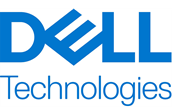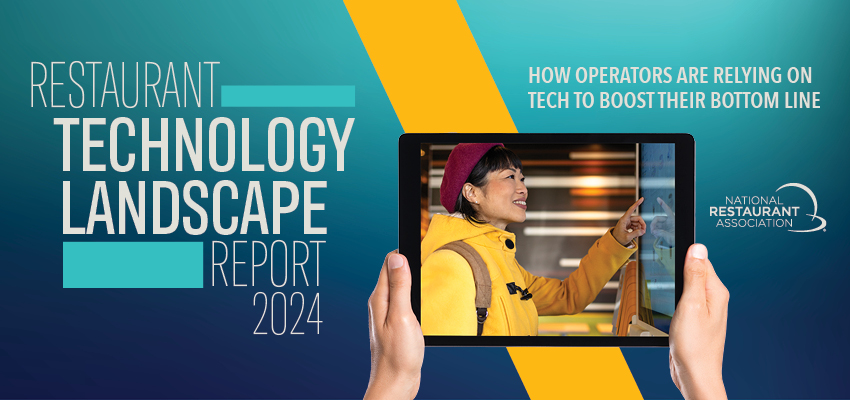Articles
May 09, 2024
Automated meal ordering and payment a draw for customers
Research reveals what customers want and don’t want when incorporating tech across all restaurant segments.

Gen Z adults, millennials and Gen Xers consistently give high ratings to tech that lets them order and pay on tablets tableside.
When it comes to dining out, consumers enjoying full-, limited-service, or off-premises experiences would like a side of technology with their orders, but only for specific applications and depending on the segment.
According to National Restaurant Association research, restaurant customers said they’d prefer using more technology when ordering and paying for meals, but aren’t quite ready to have their food prepared by automated systems or robots. They also need some time to get used to ordering from AI-generated persona on video screens.
Responses to the Association’s online survey of more than 1,000 consumers were varied, based on age group, but purchasing ease was top of mind for all.
Here are top takeaways from the Association’s Restaurant Technology Landscape Report 2024 on what consumers want and what they don’t.
The highest-rated fullservice tech options—using tech to order and pay—are a plus because customers wouldn’t have to wait for servers to take their orders and wait times for the check at the end of the meal would decrease significantly as well.
When asked which tech-related options they’d use most at fullservice restaurants, Gen Z adults, millennials and Gen Xers consistently give high ratings (60%-80%+) to tech that lets them order and pay on a tablet at the table, place orders using a smartphone app, pay their check using contactless or mobile payment options, or pay with a digital wallet (Apple Pay, Samsung Pay, Google Wallet, etc.)
Younger consumers are much more accepting of technology in fullservice restaurants. With the exception of paying the check on a tableside tablet (47%), around a quarter to third of baby boomers would likely use other tech options during their dining occasion.
Fullservice restaurant customers identified two tech options they’d need more time to get used to.
Customers further cited four additional tech options proving popular in the limited-service category.
Also, while limited-service customers don’t mind placing orders with a live person through a video screen, they’re not as enamored of interacting with an AI-generated persona just yet.
The research found that delivery customers are much more likely than on-premises customers to embrace technology.
Download the Restaurant Technology Landscape Report 2024
According to National Restaurant Association research, restaurant customers said they’d prefer using more technology when ordering and paying for meals, but aren’t quite ready to have their food prepared by automated systems or robots. They also need some time to get used to ordering from AI-generated persona on video screens.
Responses to the Association’s online survey of more than 1,000 consumers were varied, based on age group, but purchasing ease was top of mind for all.
Here are top takeaways from the Association’s Restaurant Technology Landscape Report 2024 on what consumers want and what they don’t.
Fullservice
According to the survey, customers dining out at fullservice restaurants expect and enjoy the hospitality employees provide, and that’s not likely to change anytime soon. Overall, they indicate that use of technology, though nice to have, isn’t essential.The highest-rated fullservice tech options—using tech to order and pay—are a plus because customers wouldn’t have to wait for servers to take their orders and wait times for the check at the end of the meal would decrease significantly as well.
When asked which tech-related options they’d use most at fullservice restaurants, Gen Z adults, millennials and Gen Xers consistently give high ratings (60%-80%+) to tech that lets them order and pay on a tablet at the table, place orders using a smartphone app, pay their check using contactless or mobile payment options, or pay with a digital wallet (Apple Pay, Samsung Pay, Google Wallet, etc.)
Younger consumers are much more accepting of technology in fullservice restaurants. With the exception of paying the check on a tableside tablet (47%), around a quarter to third of baby boomers would likely use other tech options during their dining occasion.
Fullservice restaurant customers identified two tech options they’d need more time to get used to.
- Food delivered to the table by automated systems or robots (37%).
- Food prepared by automated systems or robots (29%).
Limited-service
Most limited-service customers said they’d like to use technology throughout the entire dining occasion, believing it would speed transaction times, provide more accuracy, and be more efficient. Customers at quickservice restaurants, delis, and coffee shops, were asked how likely they’d be to increase their use of tech options.- 70% said they’d use a smartphone app to place an order.
- 65% said they’d use an app to pay for their meal.
Customers further cited four additional tech options proving popular in the limited-service category.
- 65% would order their food using a self-service kiosk
- 63% would use a self-service electronic kiosk to pay for their orders
- 58% would place their order with a live person via video screen
- 57% said they’d access menus on a smartphone using a QR code
Also, while limited-service customers don’t mind placing orders with a live person through a video screen, they’re not as enamored of interacting with an AI-generated persona just yet.
Delivery
Compared with the fullservice and limited-service segments, use of tech in the delivery/takeout segment is already baked into consumers’ expectations. Off-prem customers expect to access, order, customize, and pay for orders on their computer screens or smartphones, and if they can’t, they’ll order elsewhere.The research found that delivery customers are much more likely than on-premises customers to embrace technology.
- 84% of respondents said they’d place delivery orders using a restaurant’s website.
- 8 of 10 delivery customers, including nearly 6 in 10 baby boomers, said they’d place delivery orders using a smartphone app.
- 79% of delivery customers said they’d like to use contactless or mobile payment options.
- 73% would like to pay using a digital wallet, such as Apple Pay, Samsung Pay, Google Wallet, PayPal or Venmo.
- 71% say they’d be likely to order delivery through a third-party service, like DoorDash, Grubhub, Uber Eats, or Postmates.
- 45% said they’d likely order delivery using a voice-enabled platform, like Amazon Alexa, Google Home, or iPhone’s Siri.
- Fewer than 4 of 10 customers would order food delivered by a drone or robot.
- 24% said tech would provide more accurate times when orders are delivered.
- 24% said tech would make delivery faster.
- 19% said better packaging would allow for a greater variety of foods for delivery.
Download the Restaurant Technology Landscape Report 2024
Sponsored by
-
DellDell Technologies provides customers with the industry’s broadest and most innovative technology and services solutions spanning from edge to core to cloud. Through the partnership of National Restaurant Association and Dell Technologies, members will have access to a multitude of benefits to help progress your business forward.Learn more
-
SpotOnSpotOn is one of the leading software and payment companies providing the technology and support that helps local businesses—and the people who run them—to succeed on their own terms. Known for its flexible, cloud-based technology and personalized support, SpotOn offers an end-to-end platform to accept payments, boost revenue, streamline operations, and create exceptional guest experiences. From seamless and efficient point-of-sale systems to integrated restaurant management solutions, SpotOn builds technology that "works the way you work" and backs it up with a 24/7 team of experts that make sure it always does—with fairness, flexibility, and a personal touch.Learn more
Get the report
Get the report
Sign up for our Newsletter
The latest news from the National Restaurant Association, published every other Thursday
By clicking Submit I agree to receive email communications from the National Restaurant Association and agree to our Privacy Policy(Opens in a new window).


